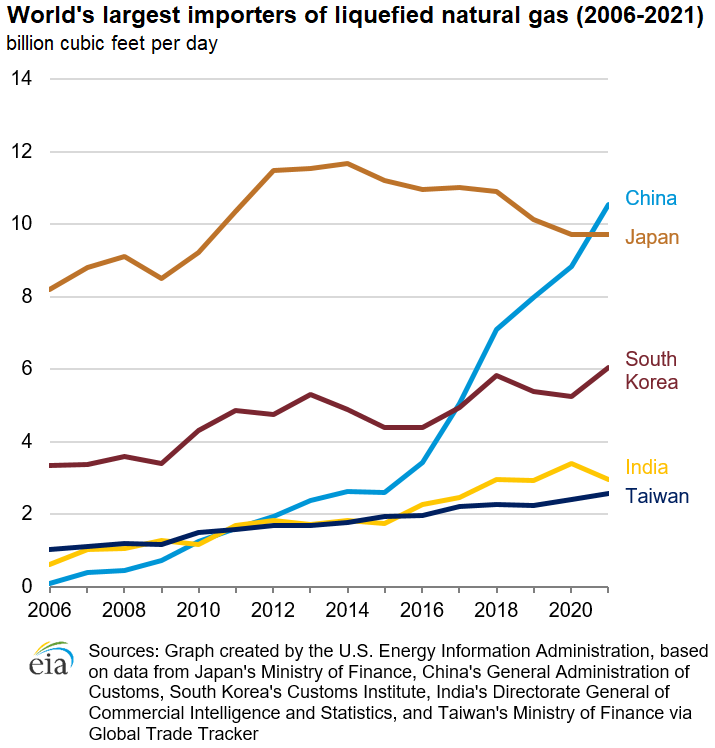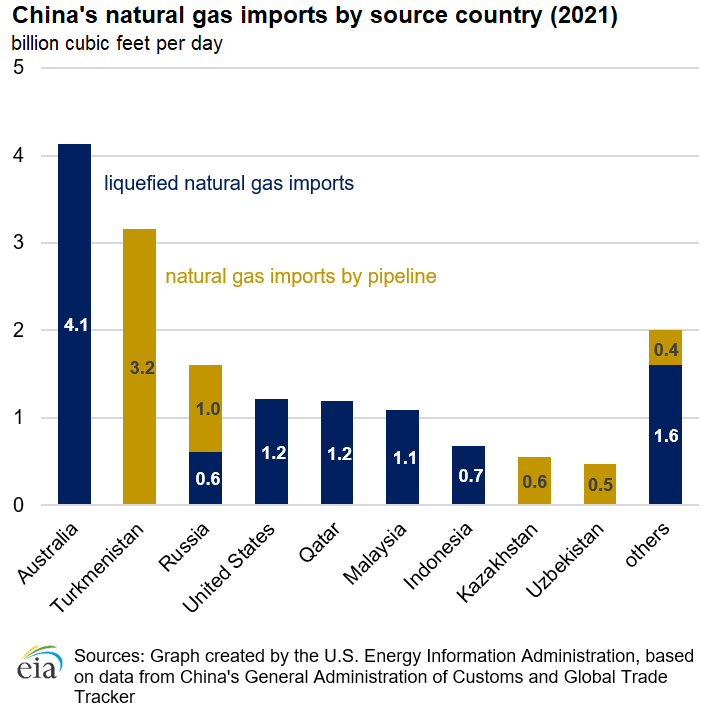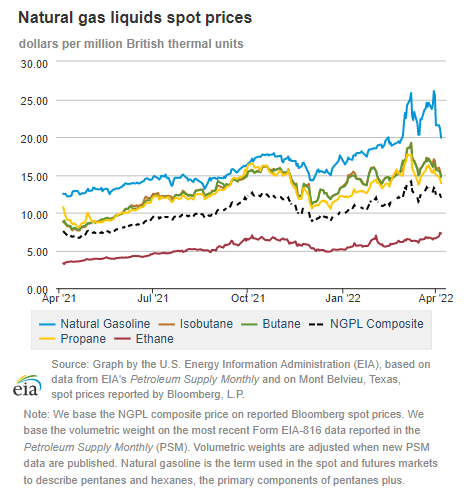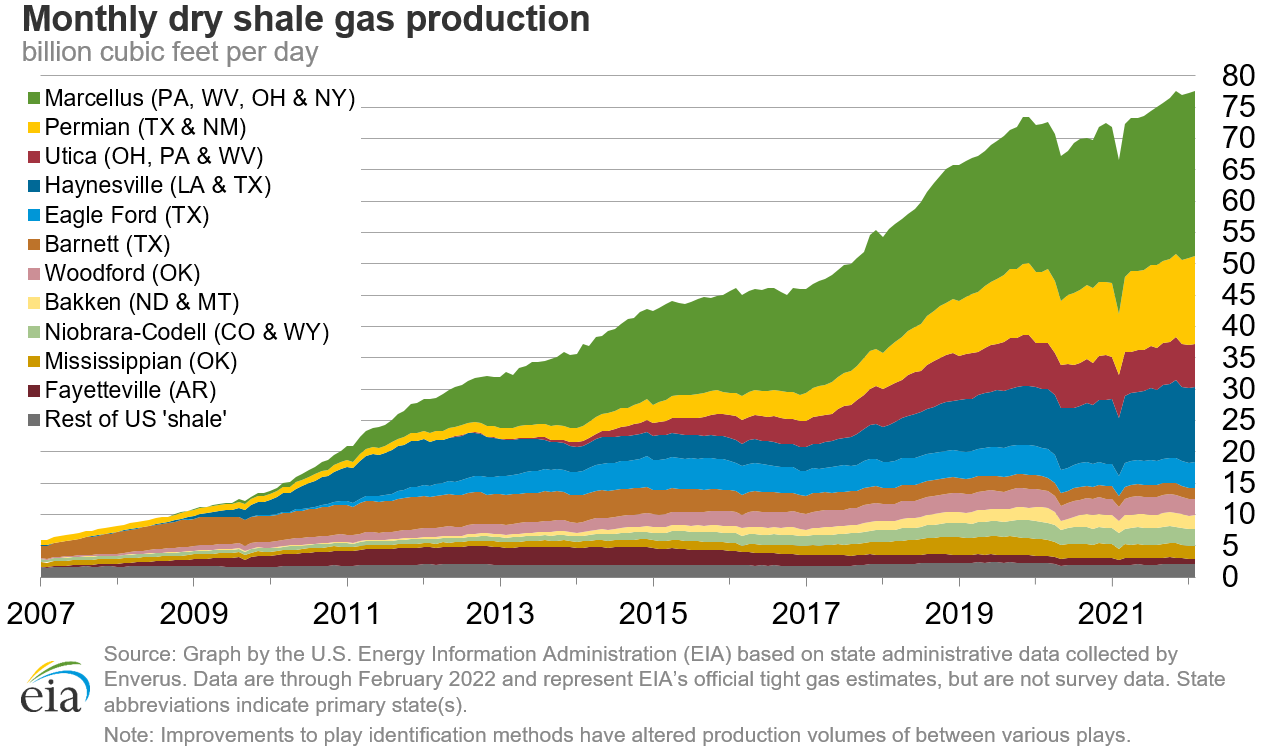In the News:
China became the world’s largest LNG importer in 2021
China’s imports of liquefied natural gas (LNG) in 2021 were the world’s largest, according to our analysis based on data from Global Trade Tracker and China’s Administration of Customs. Prior to 2021, Japan had been the world’s largest LNG importer for 51 years, according to data from Cedigaz. In 2021, China’s LNG imports averaged 10.5 billion cubic feet per day (Bcf/d), a 1.7 Bcf/d (19%) increase over 2020 and 0.8 Bcf/d more than Japan’s LNG imports. LNG imports in Japan were flat year-on-year, averaging 9.7 Bcf/d in 2020 and 2021, according to data from Japan’s Ministry of Finance.
Since China began importing LNG in 2006, China’s LNG imports have grown steadily every year, except in 2015. Growth in China’s LNG imports has been supported by the rapid expansion of LNG import capacity, which has reached an estimated 13.9 Bcf/d last year. By the end of 2022, China’s regasification capacity is expected to expand by an additional 2.8 Bcf/d, for a total of 16.7 Bcf/d, according to data by S&P Global Platts.
China’s natural gas imports, both by pipeline and as LNG, accounted for nearly half (46%) of China’s total natural gas supply (35.5 Bcf/d) in 2021, an increase from 15% in 2010. Last year, natural gas imports by pipeline provided 16% (5.7 Bcf/d) of total supply, while LNG imports accounted for 30% (10.5 Bcf/d). In 2021:
- China imported natural gas by pipeline from five countries: Turkmenistan (3.2 Bcf/d), Russia (1.0 Bcf/d), Kazakhstan (0.6 Bcf/d), Uzbekistan (0.5 Bcf/d), and Myanmar (0.4 Bcf/d).
- China imported LNG from 25 countries. The six largest suppliers—Australia, the United States, Qatar, Malaysia, Indonesia, and Russia—provided 8.9 Bcf/d, or 85% of total LNG imports.
- The remaining 15% of LNG was imported from 6 countries in Africa (0.6 Bcf/d, or 6% of total LNG imports), 3 countries in the Middle East (0.4 Bcf/d, or 4%) and 10 other countries from the rest of the world (0.6 Bcf/d, or 5%).
Rapid growth in China’s natural gas production and imports has been driven primarily by government policies promoting coal-to-natural gas switching in an effort to reduce air pollution and meet emissions targets. In 2021, China’s domestic production reached 19.3 Bcf/d, accounting for 54% of the country’s total natural gas supply, while pipeline and LNG imports combined were at 16.2 Bcf/d (46%). In March 2022, the Chinese government released its 14th Five-Year Plan (2021–2025), which set domestic natural gas production target at 22.3 Bcf/d by 2025, an increase of 3.0 Bcf/d compared with 2021.
Overview:
(For the week ending Wednesday, April 6, 2022)
- Spot Prices: Natural gas spot prices rose at most locations this report week (Wednesday, March 30 to Wednesday, April 6). The Henry Hub spot price rose from $5.34 per million British thermal units (MMBtu) last Wednesday to $6.25/MMBtu yesterday.
- International Spot Prices: Bloomberg Finance, L.P. reports that swap prices for liquefied natural gas (LNG) cargoes in East Asia fell $0.36/MMBtu to a weekly average of $34.05/MMBtu. At the Title Transfer Facility (TTF) in the Netherlands, the most liquid natural gas spot market in Europe, the day-ahead prices rose $1.50 to a weekly average of $36.17/MMBtu. TTF prices averaged higher than East Asia spot prices for the second consecutive week as concerns about natural gas imports from Russia resulted in higher prices to attract flexible LNG cargoes. In the same week last year (week ending April 7, 2021), prices in East Asia and at the TTF were $6.95/MMBtu and $6.84/MMBtu, respectively.
- Futures: The price of the May 2022 NYMEX contract increased 42.4 cents, from $5.605/MMBtu last Wednesday to $6.029/MMBtu yesterday. The price of the 12-month strip averaging May 2022 through April 2023 futures contracts climbed 46.8 cents to $6.029/MMBtu.
- Storage: The net withdrawals from working gas totaled 33 billion cubic feet (Bcf) for the week ending April 1. Working natural gas stocks totaled 1,382 Bcf, which is 22% lower than the year-ago level and 17% lower than the five-year (2017–2021) average for this week.
- NGPLs: The natural gas plant liquids (NGPLs) composite price at Mont Belvieu, Texas, fell 64 cents/MMBtu, averaging $12.43/MMBtu for the week ending April 6. Natural gas prices at the Houston Ship Channel increased by 13%, while the ethane price rose 5%. The ethane premium to natural gas narrowed by 33 cents/MMBtu (21%). The price of ethylene decreased by 14%, narrowing the premium to ethane by 31% week over week. The Brent crude oil price decreased by 8%, pulling down the prices of propane, butanes, and natural gasoline. The propane and normal butane prices fell by 7%, while the price of isobutane and natural gasoline fell by 6% and 11%, respectively. The propane discount to crude oil narrowed by 12%.
- Rigs: According to Baker Hughes, for the week ending Tuesday, March 29, the natural gas rig count was up by one rig from a week ago at 138 rigs. The Eagle Ford and the Marcellus each added one rig, and the Haynesville dropped one rig. The number of oil-directed rigs increased by 2 rigs to 533 rigs. The Permian added four rigs, and the Cana Woodford added one rig; one rig each was dropped in the Eagle Ford, the Williston, and an unspecified location. The total rig count now stands at 673, the highest level since March 27, 2020, and 243 rigs more than the same week last year.
Prices/Supply/Demand:
Prices along the Gulf Coast increase as temperatures rise. This report week (Wednesday, March 30 to Wednesday, April 6), the Henry Hub spot price rose 91 cents from $5.34/MMBtu last Wednesday to $6.25/MMBtu yesterday. Prices along the Gulf Coast and across the Southeast were all higher this report week along with the NYMEX Henry Hub futures contract. Feedgas deliveries to liquefied natural gas (LNG) export terminals along the Gulf Coast decreased by 0.6 billion cubic feet per day (Bcf/d) (5%) to 11.3 Bcf/d this report week. On March 30, Venture Global received FERC approval to commission liquefaction Block 6 at Calcasieu Pass.
Prices in the Midwest rise in line with the general trend in prices across the United States. At the Chicago Citygate, the price increased $1.10 from $5.14/MMBtu last Wednesday to $6.24/MMBtu yesterday. Temperatures in the Chicago area averaged 43°F this report week, which is 2°F lower than normal.
Prices in the West rise in response to maintenance and warmer temperatures moving into the region. The price at PG&E Citygate in Northern California rose 80 cents, up from $6.05/MMBtu last Wednesday to $6.85/MMBtu yesterday. The price at Malin, Oregon, the northern delivery point into the PG&E service territory, rose $1.09 from $4.85/MMBtu last Wednesday to $5.94/MMBtu yesterday. The price at Sumas on the Canada-Washington border, the main pricing point for the Pacific Northwest, rose $1.31 from $4.55/MMBtu last Wednesday to $5.86/MMBtu yesterday. The price at Kingsgate on the Idaho-Canada border increased $1.10/MMBtu from $4.52/MMBtu last Wednesday to $5.62 yesterday. Nova Gas Transmission Ltd. began maintenance on its Burton Creek A3 compressor in Canada, reducing flows to the Pacific Northwest. The price at SoCal Citygate in Southern California increased $1.21 from $5.08/MMBtu last Wednesday to $6.29/MMBtu yesterday. NOAA reports temperatures at Riverside, California, inland from Los Angeles, reached a high of 97°F on Wednesday resulting in 10 cooling degree days (CDDs) more than normal. Planned maintenance on the El Paso Natural Gas system between the Wind and Black River compressor stations in West Texas is expected to impact westbound flows of natural gas. The maintenance is related to ongoing work to resolve the Line 2000 force majeure declared last August.
Prices in the Northeast increase despite normal temperatures and lower local demand. At the Algonquin Citygate, which serves Boston-area consumers, the price went up $1.60 from $4.79/MMBtu last Wednesday to $6.39/MMBtu yesterday. At the Transcontinental Pipeline Zone 6 trading point for New York City, the price increased $1.64 from $4.61/MMBtu last Wednesday to $6.25/MMBtu yesterday. Natural gas demand in the Northeast declined by 3.7 Bcf/d (9%) to 35.4 Bcf/d, which was led by a decrease of 4.0 Bcf/d (31%) to 8.8 Bcf/d in the residential and commercial sectors, according to data from PointLogic. Net natural gas flows out of the Northeast increased by 1.3 Bcf/d (10%) to an average 13.9 Bcf/d this week which partially offset the decline in overall demand.
Prices in the Appalachia production region rise, following similar trends in prices across the country. The Tennessee Zone 4 Marcellus spot price increased $1.44 from $4.49/MMBtu last Wednesday to $5.93/MMBtu yesterday. The price at Eastern Gas South in southwest Pennsylvania rose $1.36 from $4.59/MMBtu last Wednesday to $5.95/MMBtu yesterday. Natural gas flows to the Midwest increased by 0.3 Bcf/d (6%) to 5.7 Bcf/d, according to data from PointLogic. However, natural gas flows to the New York and New Jersey area decreased by 1.1 Bcf/d (11%) to 8.5 Bcf/d, resulting in lower net natural gas flows out of the region week over week to 25.5 Bcf/d.
Prices in the Permian production region increase, narrowing the discount to Henry Hub. The price at the Waha Hub in West Texas, which is located near Permian Basin production activities, rose $1.72 this report week, from $4.02/MMBtu last Wednesday to $5.74/MMBtu yesterday. The Waha Hub traded 51 cents below the Henry Hub price yesterday, compared to last Wednesday when it traded $1.32 below the Henry Hub price. Prices in West Texas are higher week over week despite planned maintenance on the El Paso Natural Gas system, which is related to resolving the force majeure of Line 2000 declared in August 2021 (see West Coast section for additional information). Natural gas flows to the west from the Permian production region were down 0.1 Bcf/d (5%) to 2.9 Bcf/d, according to data from PointLogic.
U.S. supply of natural gas rises slightly this week. The average total supply of natural gas rose by 0.8% (0.8 Bcf/d) compared with the previous report week, according to data from PointLogic. Dry natural gas production grew by 0.8% (0.7 Bcf/d) compared with the previous report week, and average net imports from Canada increased by 1.9% (0.1 Bcf/d).
U.S. demand for natural gas is down in nearly all sectors this week. Total U.S. consumption of natural gas fell by 9.5% (7.6 Bcf/d) compared with the previous report week, with lower consumption across all sectors, according to data from PointLogic. The largest decrease this week was in the residential and commercial sectors, where consumption declined by 21.8% (6.5 Bcf/d) with average temperatures being close to normal in the largest heating centers of the United States this week, according to NOAA. Natural gas consumed for power generation declined by 1.7% (0.4 Bcf/d) week over week, and industrial sector consumption decreased by 2.8% (0.7 Bcf/d) week over week. Natural gas exports to Mexico increased 5.0% (0.3 Bcf/d) and natural gas deliveries to U.S. LNG export facilities (LNG pipeline receipts) averaged 12.5 Bcf/d, or 0.7 Bcf/d lower than last week.
U.S. LNG exports decrease by two vessels this week from last week. Twenty-three LNG vessels (nine from Sabine Pass; four each from Cameron, Corpus Christi, and Freeport; and one each from Cove Point and Elba Island) with a combined LNG-carrying capacity of 86 Bcf departed the United States between March 31 and April 6, according to shipping data provided by Bloomberg Finance, L.P.
Storage:
The net withdrawals from storage totaled 33 Bcf for the week ending April 1, compared with the five-year (2017–2021) average net injections of 8 Bcf and last year's net injections of 19 Bcf during the same week. Working natural gas stocks totaled 1,382 Bcf, which is 285 Bcf lower than the five-year average and 399 Bcf lower than last year at this time.
According to The Desk survey of natural ggas analysts, estimates of the weekly net change to working natural gas stocks ranged from net withdrawals of 20 Bcf to 44 Bcf, with a median estimate of 28 Bcf.
More storage data and analysis can be found on the Natural Gas Storage Dashboard and the Weekly Natural Gas Storage Report.
See also:
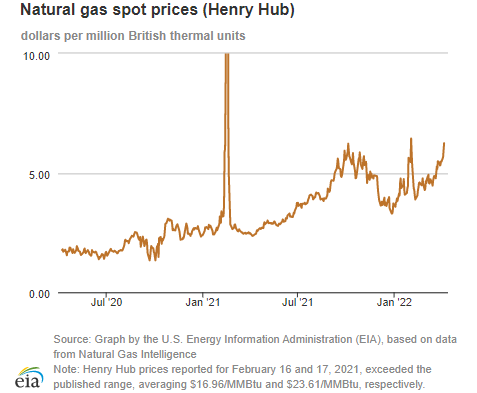
| Spot Prices ($/MMBtu) | Thu, 31-Mar |
Fri, 01-Apr |
Mon, 04-Apr |
Tue, 05-Apr |
Wed, 06-Apr |
|---|---|---|---|---|---|
| Henry Hub |
5.48 |
5.47 |
5.66 |
5.96 |
6.25 |
| New York |
5.33 |
5.22 |
5.43 |
5.75 |
6.25 |
| Chicago |
5.39 |
5.44 |
5.55 |
5.88 |
6.24 |
| Cal. Comp. Avg.* |
5.43 |
5.51 |
5.70 |
6.03 |
6.27 |
| Futures ($/MMBtu) | |||||
| May contract | 5.642 |
5.720 |
5.712 |
6.032 |
6.029 |
| June contract |
5.701 |
5.795 |
5.793 |
6.108 |
6.107 |
| *Avg. of NGI's reported prices for: Malin, PG&E Citygate, and Southern California Border Avg. | |||||
| Source: NGI's Daily Gas Price Index | |||||
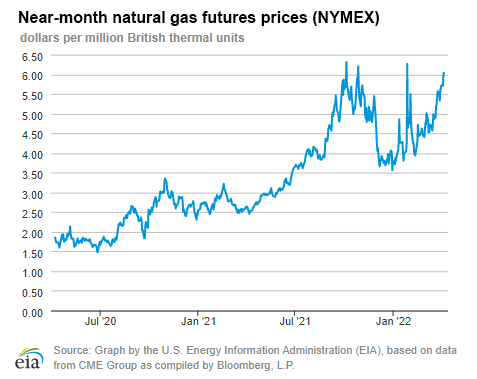
| U.S. natural gas supply - Gas Week: (3/31/22 - 4/6/22) | |||
|---|---|---|---|
Average daily values (billion cubic feet) |
|||
this week |
last week |
last year |
|
| Marketed production | 107.0 |
106.4 |
105.6 |
| Dry production | 94.8 |
94.1 |
93.2 |
| Net Canada imports | 5.5 |
5.4 |
4.5 |
| LNG pipeline deliveries | 0.1 |
0.1 |
0.1 |
| Total supply | 100.3 |
99.6 |
97.8 |
|
Source: Chart by the U.S. Energy Information Administration (EIA), based on data from PointLogic | |||
| U.S. natural gas consumption - Gas Week: (3/31/22 - 4/6/22) | |||
|---|---|---|---|
Average daily values (billion cubic feet) |
|||
this week |
last week |
last year |
|
| U.S. consumption | 72.1 |
79.7 |
70.5 |
| Power | 25.8 |
26.2 |
23.7 |
| Industrial | 23.0 |
23.7 |
22.6 |
| Residential/commercial | 23.3 |
29.8 |
24.2 |
| Mexico exports | 5.7 |
5.4 |
5.5 |
| Pipeline fuel use/losses | 6.6 |
6.7 |
6.5 |
| LNG pipeline receipts | 12.5 |
13.2 |
11.8 |
| Total demand | 96.9 |
105.1 |
94.2 |
|
Source: Chart by the U.S. Energy Information Administration (EIA), based on data from PointLogic | |||
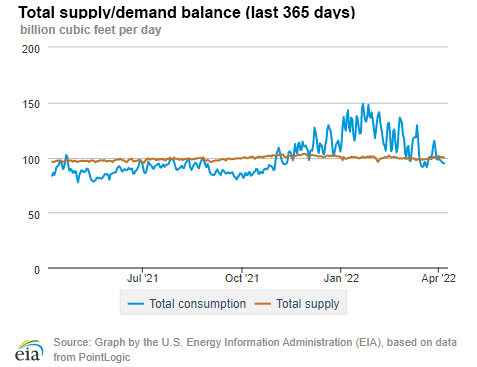
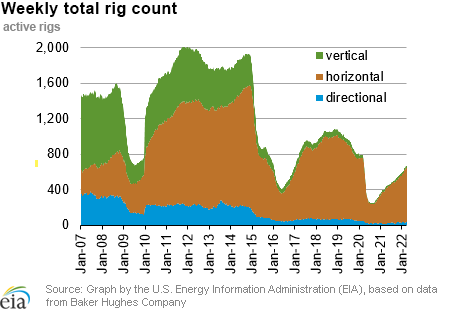
| Rigs | |||
|---|---|---|---|
Tue, March 29, 2022 |
Change from |
||
last week |
last year |
||
| Oil rigs | 533 |
0.4% |
58.2% |
| Natural gas rigs | 138 |
0.7% |
51.6% |
| Note: Excludes any miscellaneous rigs | |||
| Rig numbers by type | |||
|---|---|---|---|
Tue, March 29, 2022 |
Change from |
||
last week |
last year |
||
| Vertical | 25 |
0.0% |
25.0% |
| Horizontal | 613 |
0.5% |
56.8% |
| Directional | 35 |
0.0% |
84.2% |
| Source: Chart by the U.S. Energy Information Administration (EIA), based on data from Baker Hughes Company | |||
| Working gas in underground storage | ||||
|---|---|---|---|---|
Stocks billion cubic feet (Bcf) |
||||
| Region | 2022-04-01 |
2022-03-25 |
change |
|
| East | 241 |
268 |
-27 |
|
| Midwest | 296 |
317 |
-21 |
|
| Mountain | 91 |
89 |
2 |
|
| Pacific | 165 |
161 |
4 |
|
| South Central | 589 |
581 |
8 |
|
| Total | 1,382 |
1,415 |
-33 |
|
|
Source: U.S. Energy Information Administration Form EIA-912, Weekly Underground Natural Gas Storage Report | ||||
| Working gas in underground storage | |||||
|---|---|---|---|---|---|
Historical comparisons |
|||||
Year ago (4/1/21) |
5-year average (2017-2021) |
||||
| Region | Stocks (Bcf) |
% change |
Stocks (Bcf) |
% change |
|
| East | 305 |
-21.0 |
278 |
-13.3 |
|
| Midwest | 398 |
-25.6 |
371 |
-20.2 |
|
| Mountain | 115 |
-20.9 |
100 |
-9.0 |
|
| Pacific | 197 |
-16.2 |
180 |
-8.3 |
|
| South Central | 765 |
-23.0 |
739 |
-20.3 |
|
| Total | 1,781 |
-22.4 |
1,667 |
-17.1 |
|
| Source: U.S. Energy Information Administration Form EIA-912, Weekly Underground Natural Gas Storage Report | |||||
| Temperature – heating & cooling degree days (week ending Mar 31) | ||||||||
|---|---|---|---|---|---|---|---|---|
HDDs |
CDDs |
|||||||
| Region | Current total |
Deviation from normal |
Deviation from last year |
Current total |
Deviation from normal |
Deviation from last year |
||
| New England | 188 |
14 |
82 |
0 |
0 |
0 |
||
| Middle Atlantic | 189 |
31 |
102 |
0 |
0 |
0 |
||
| E N Central | 200 |
36 |
73 |
0 |
0 |
0 |
||
| W N Central | 192 |
31 |
45 |
0 |
-1 |
0 |
||
| South Atlantic | 104 |
17 |
63 |
13 |
0 |
-18 |
||
| E S Central | 91 |
9 |
41 |
2 |
-3 |
-5 |
||
| W S Central | 33 |
-12 |
2 |
22 |
8 |
2 |
||
| Mountain | 103 |
-37 |
-52 |
6 |
2 |
4 |
||
| Pacific | 66 |
-16 |
-8 |
0 |
-2 |
0 |
||
| United States | 136 |
12 |
42 |
6 |
1 |
-3 |
||
|
Source: Chart by the U.S. Energy Information Administration (EIA), based on data from the National Oceanic and Atmospheric Administration Note: HDDs=heating degree days; CDDs=cooling degree days | ||||||||
Average temperature (°F)
7-day mean ending Mar 31, 2022
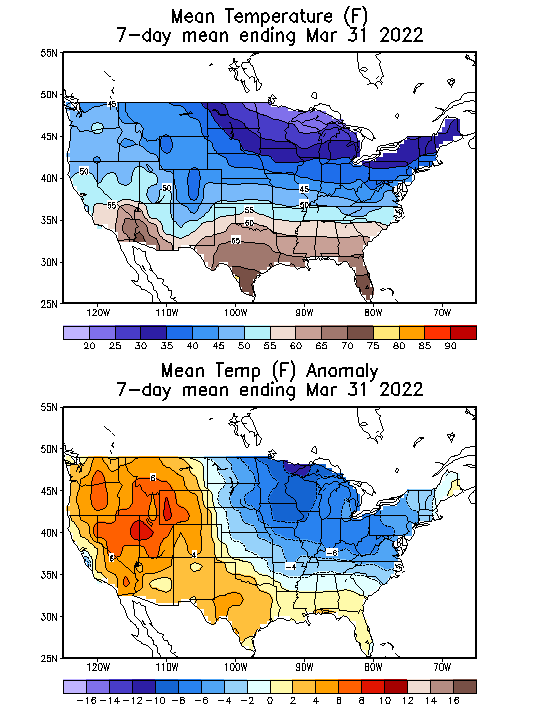
Source: National Oceanic and Atmospheric Administration Note: Image is not available.
Deviation between average and normal (°F)
7-day mean ending Mar 31, 2022

Source: National Oceanic and Atmospheric Administration Note: Image is not available.

